MENU
Starting a Business
- Best Small Business Loans
- Best Business Internet Service
- Best Online Payroll Service
- Best Business Phone Systems
Our Top Picks
- OnPay Payroll Review
- ADP Payroll Review
- Ooma Office Review
- RingCentral Review
Our In-Depth Reviews
Finance
- Best Accounting Software
- Best Merchant Services Providers
- Best Credit Card Processors
- Best Mobile Credit Card Processors
Our Top Picks
- Clover Review
- Merchant One Review
- QuickBooks Online Review
- Xero Accounting Review
Our In-Depth Reviews
- Accounting
- Finances
- Financial Solutions
- Funding
Explore More
Human Resources
- Best Human Resources Outsourcing Services
- Best Time and Attendance Software
- Best PEO Services
- Best Business Employee Retirement Plans
Our Top Picks
- Bambee Review
- Rippling HR Software Review
- TriNet Review
- Gusto Payroll Review
Our In-Depth Reviews
- Employees
- HR Solutions
- Hiring
- Managing
Explore More
Marketing and Sales
- Best Text Message Marketing Services
- Best CRM Software
- Best Email Marketing Services
- Best Website Builders
Our Top Picks
- Textedly Review
- Salesforce Review
- EZ Texting Review
- Textline Review
Our In-Depth Reviews
Technology
- Best GPS Fleet Management Software
- Best POS Systems
- Best Employee Monitoring Software
- Best Document Management Software
Our Top Picks
- Verizon Connect Fleet GPS Review
- Zoom Review
- Samsara Review
- Zoho CRM Review
Our In-Depth Reviews
Business Basics
- 4 Simple Steps to Valuing Your Small Business
- How to Write a Business Growth Plan
- 12 Business Skills You Need to Master
- How to Start a One-Person Business
Our Top Picks
The Best Spreadsheet Software: Features, Uses and Programs

Table of Contents
Spreadsheet software can be incredibly helpful for business owners looking to streamline their data collection and organization. You can use spreadsheet software for various parts of your business, from accounting to HR management. Here’s everything you need to know when choosing the best spreadsheet software for your business.
What is spreadsheet software?
Spreadsheet software is used to store, organize and analyze data. Most of the time, that data is numerical, though spreadsheets can also store addresses and contact information.
Spreadsheets automatically calculate data based on the formulas or functions you create and modify for them. For example, let’s say you’re using a spreadsheet to track how much money you’re using from a budget. You can set up the spreadsheet so that every time you enter an item you purchased from the budget, the software subtracts the cost from the total budget. If the budget starts at $5,000 and you buy a product that is $400, input the product and its cost into the spreadsheet, and the software automatically does the calculation, showing your remaining budget of $4,600.
The data in spreadsheets is represented in individual cells. These cells are organized in vertical rows and horizontal columns. They can be resized so you can see all your data at once. Most spreadsheet software lets you create data visualizations for your information. The type of visual elements depends on the software you use; however, the most common are charts and graphs.
Spreadsheet software can help business owners keep track of and streamline their data, automatically calculating costs for them. This both saves time and reduces the risk of human error, which can free up time and energy spent manually inputting data into spreadsheets.
What is the best spreadsheet software?
When choosing spreadsheet software for your business, one or two programs may come to mind. However, many different types of spreadsheet applications offer different advantages depending on the user.
Here are a few of the most popular spreadsheet software programs and why business owners love them:
1. Microsoft Excel

Image source: Microsoft Excel
Introduced in the late 1980s, Microsoft Excel is one of the most popular and well-known spreadsheet software programs. It is often viewed as the gold standard of spreadsheets and offers many features, from basic mathematical formulas to more complex automations and programming solutions via Visual Basic for Applications (VBA) macros. Excel is accessible as a desktop software or web-based application for licensed Microsoft Office users.
“I use Microsoft Excel most often because of its versatility and wide user base,” said Michael Sena, lead analytics consultant at SENACEA. “The Excel web app also comes in handy, allowing you to embed spreadsheets on the website. It can be miraculous for creating online calculators.”
2. Google Sheets

Image source: Google Sheets
Google’s spreadsheet software is a built-in feature of every free personal and business Gmail account. As part of Google Workspace, Google Sheets integrates with other programs such as Google Analytics, Looker Studio and Google Forms, which makes it easy to import and export data from your spreadsheet. Many business owners prefer Google Sheets due to its cloud and web-based “anywhere” access, and the familiar interface and functionality that mirrors Microsoft Excel.
“Although Excel has a cloud platform, it is difficult if a device doesn’t operate with an official Microsoft Office license,” said Stephen Light, co-owner and chief executive officer at Nolah Sleep. “Google Sheets doesn’t require any downloads and is easily accessible by merely typing the site URL sheets.google.com.”
3. Airtable

Image source: Airtable
Airtable can function as a basic spreadsheet, but this robust tool can also be switched to a calendar, Kanban, form or gallery view to help users visualize the same data differently. Its highly customizable user interface also allows you to create relationships between data sets within each “base” or table, and can be integrated with external services to build a powerful business management tool.
“Airtable provides the ability to create automatic routines,” said Andy Kolodgie, co-owner of The House Guys. “For example, users can design a form in Airtable, post it to Facebook and automatically return all the responses from the form into Airtable — and then create relationships based on that data.”
4. Apache OpenOffice
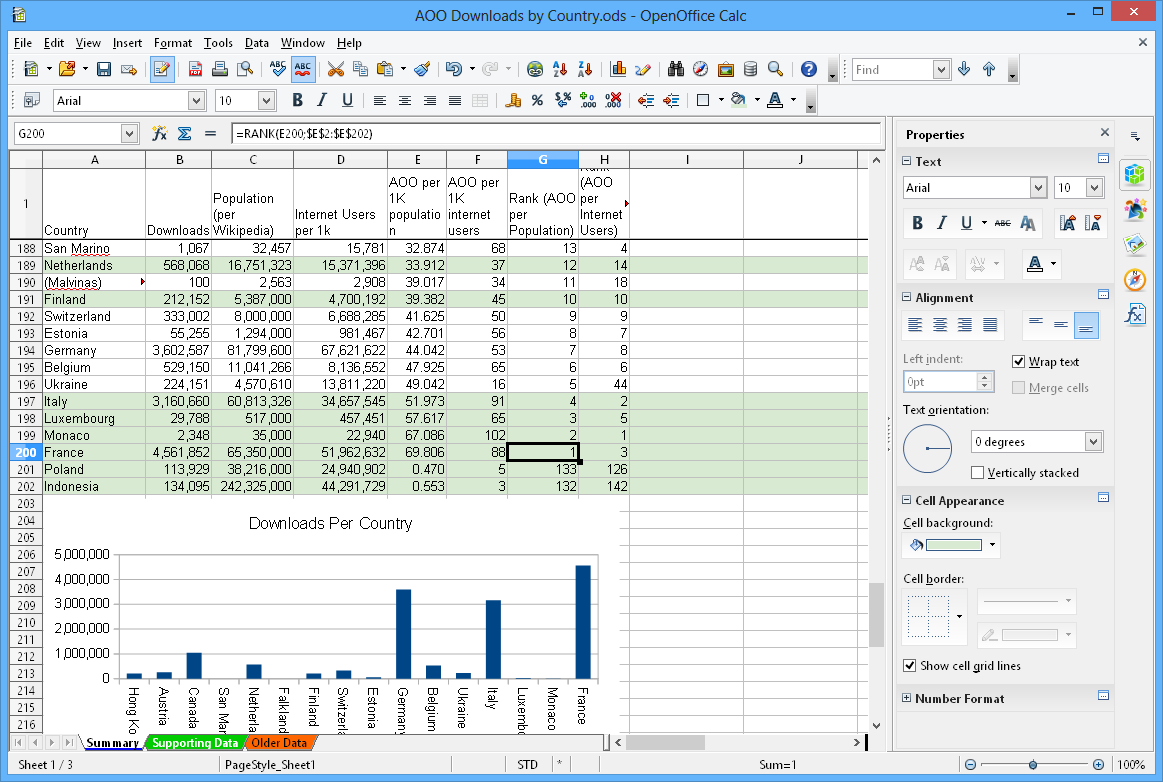
Image source: Apache OpenOffice
Apache OpenOffice offers a basic spreadsheet application with its free, open-source productivity suite. It supports multiple file formats, including those from Visio, Corel Draw and Microsoft Publisher. ODS files are also compatible for upload to Google Sheets.
“Open-source [software like OpenOffice] is a great option, as it costs nothing and has a community of developers behind it, which continuously helps improve the functionality and usability of the software,” said Jonathan Kelly, natural link acquisition specialist at 1stonthelist.com. “[It also] offers many add-ons/plugins to make the productivity of the software even more streamlined.”
5. Handsontable
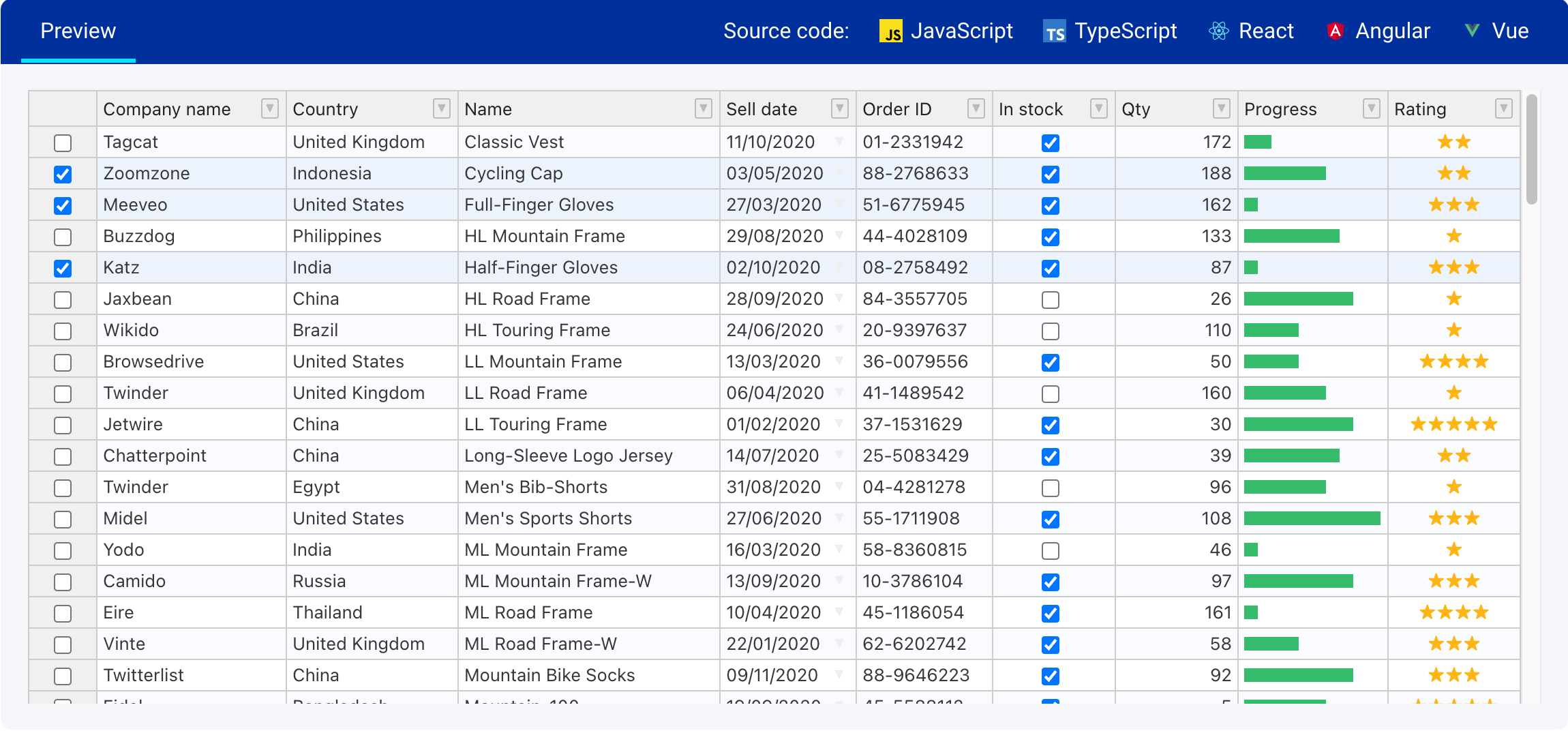
Image source: Handsontable
At a glance, this JavaScript data grid looks and feels like Microsoft Excel. However, Handsontable has dozens of customization features via useful plugins. Tech-savvy users can edit the source code to suit their specific needs.
“[With Handsontable], I can work with large volumes of data without concern of slowdowns or other performance issues,” said James Surrey, founder and editor at Review Home Warranties. “As someone who [has] a lot of data to analyze and sort through, these are all important features that make my daily assignments more hassle-free.”
6. Sheetgo
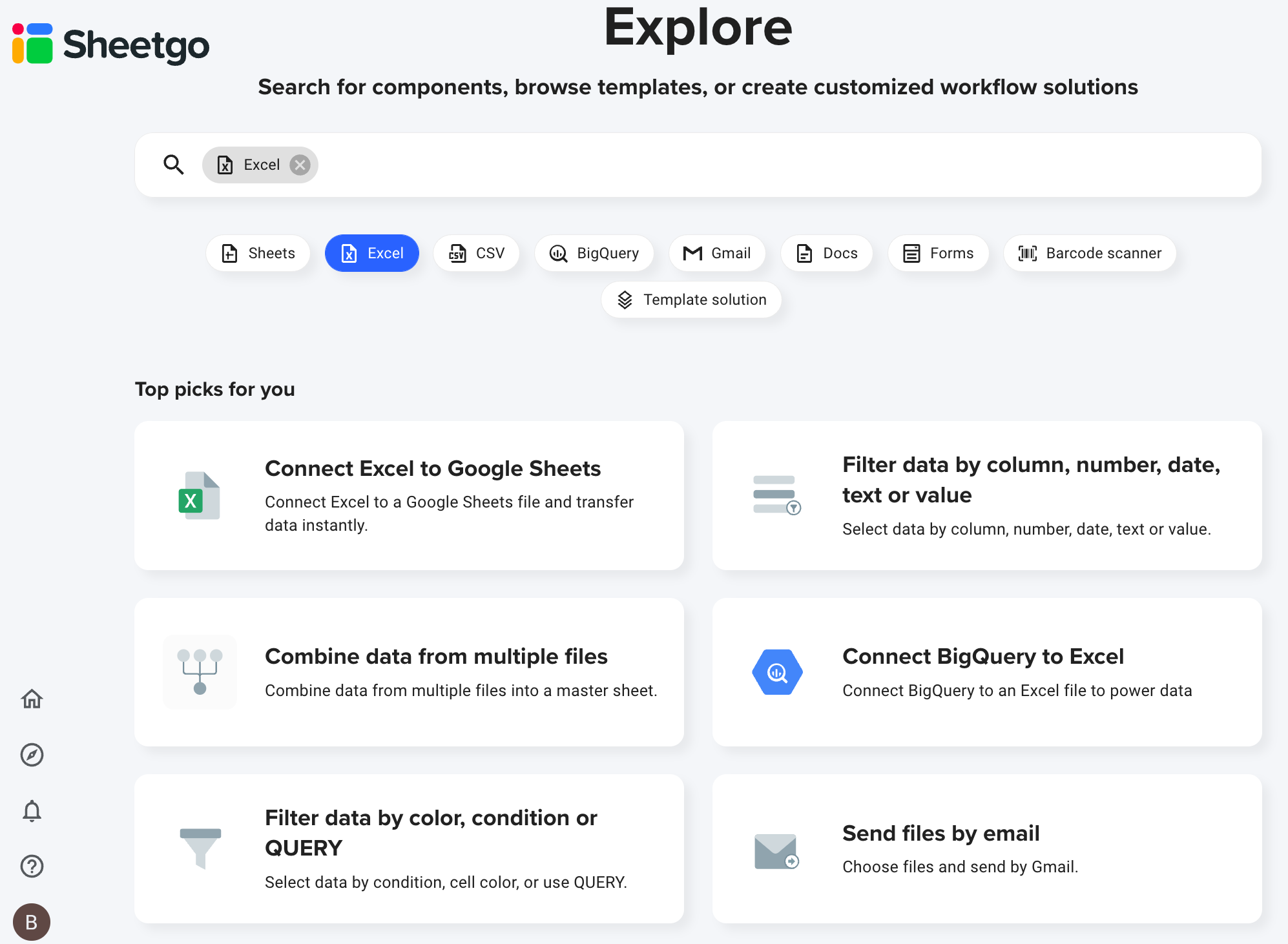
Image source: Sheetgo
This no-code automation tool lets you and your team collect, manage and share data and create custom workflows within a familiar spreadsheet format. With Sheetgo, you can create remote connections with other Sheetgo users and transfer files, including ones stored in Google Drive folders.
“Being able to transport Excel sheets makes it easy to share files with my employees — all of whom are working remotely at the moment,” Michael Kipness, founder of Wizard Race and Sports told business.com. “I can transfer entire sheets or just single columns, rows or specific cell colors. The easy sharing ensures my staff and I look at the same sheets.”
7. Smartsheet
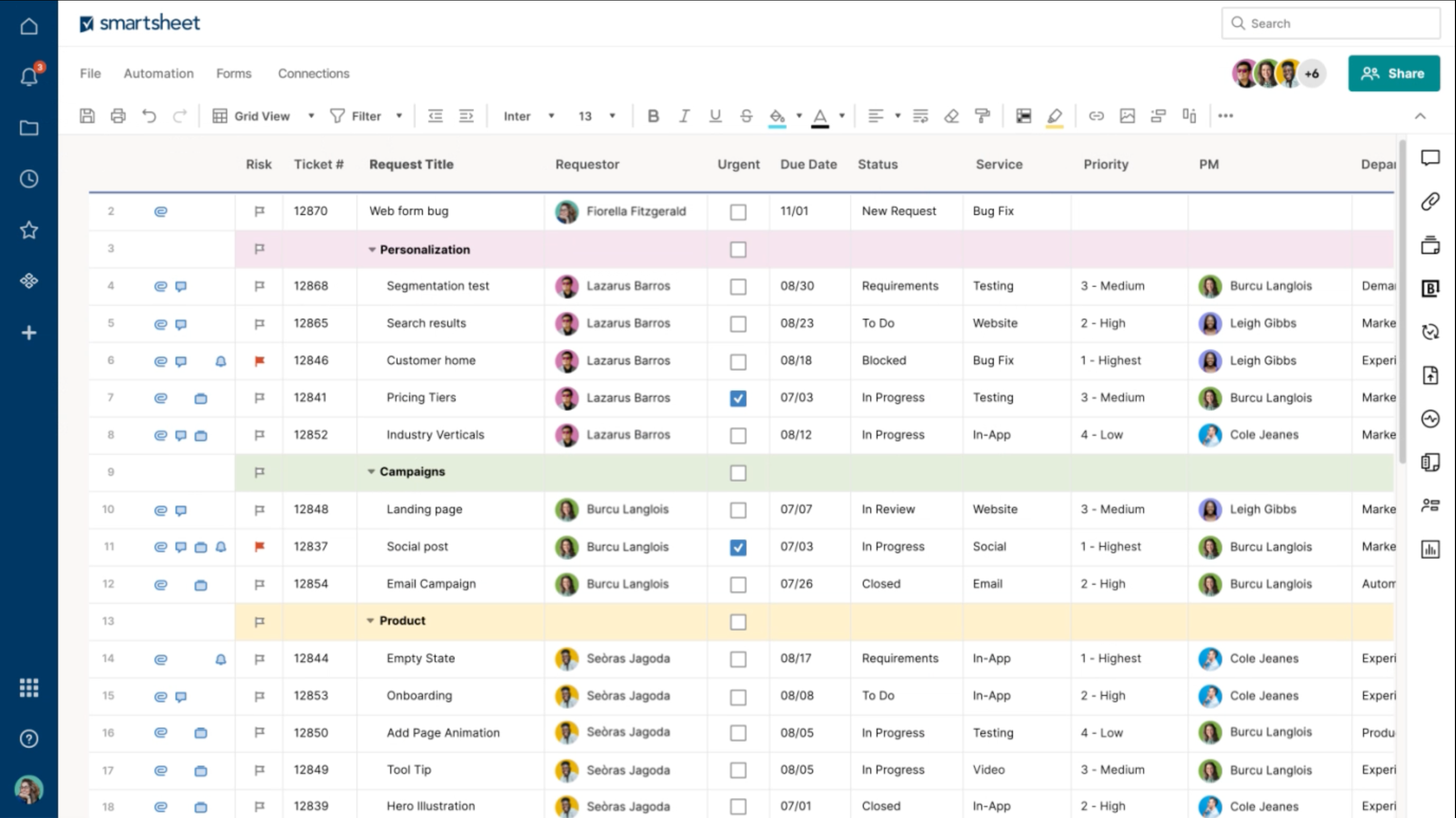
Image source: Smartsheet
If you use spreadsheets for project data rather than numbers, Smartsheet is a great option. Its simple user interface allows you and your team to manage projects and create reports all in one place. Smartsheet also includes a handy form feature that can be distributed to clients, employees and other business contacts. When they fill out the form, the software feeds their data into your sheet.
“We use [Smartsheet] for metrics and pull everything into dashboards, which really helps, because we can track what number and type of transactions are happening with each client,” said Vicky Brown, president and CEO of Idomeneo Enterprises Inc. “We also use the application extensively for onboarding new employees and clients.”
8. Zoho Sheet
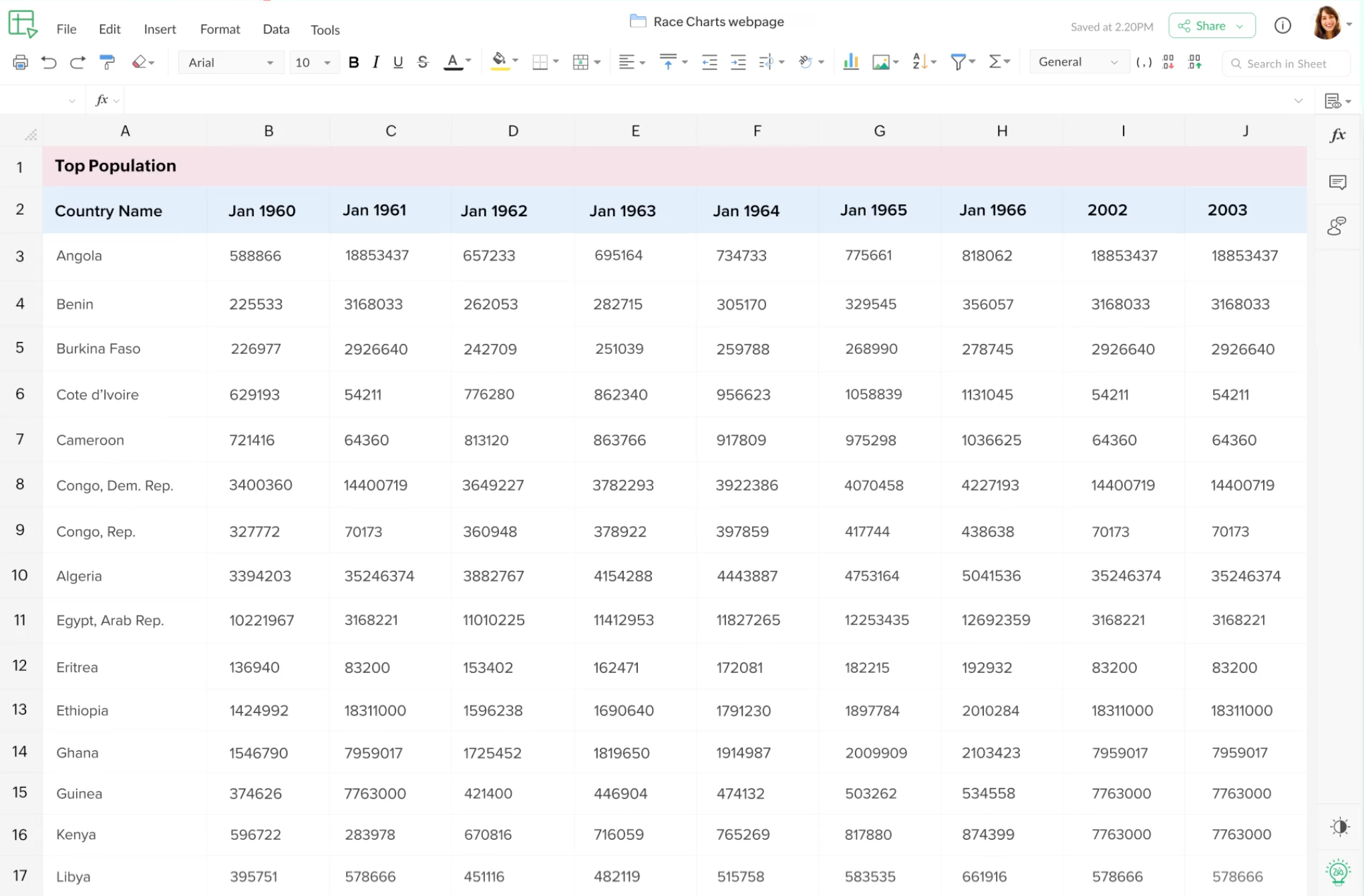
Image source: Zoho Sheet
Zoho Sheet is another free spreadsheet web application with abundant features. There are over 350 functions available, including an option to create custom functions in your spreadsheets using minimal coding.
“We primarily use [Zoho Sheet] because of how powerful the collaboration tools are,” said Rex Freiberger, CEO of Gadget Review. “I’ve found it far less laggy than Google Sheets. There’s also real-time chat and the ability to preserve past changes in case something needs to be discussed.”
Various popular types of spreadsheet software are available, including Microsoft Excel, Google Sheets, Airtable, Apache OpenOffice, Handsontable, Sheetgo, Smartsheet and Zoho Sheet. When deciding between one of these (or other) popular spreadsheets, consider what your business’s unique needs are, what you will use the spreadsheet for, and what your budget is.
What can I use spreadsheet software for?
While spreadsheets originated in the world of finance, today’s software does more than track your budget. It can perform many tasks that save you time and money if used correctly. Spreadsheet software can allow employees to work more efficiently, giving you and your team a better workflow. Below are some common functions a spreadsheet can serve for a business.
Accounting
Spreadsheets can keep track of simple numerical data such as your budget, but you can also use them to implement whole accounting systems. You can use a spreadsheet to keep track of invoices you send customers and ones you receive from vendors. You can also use them to track employee wages, including overtime, paid time off and sick leave. [Read more about The Best Accounting and Invoice-Generating Software for 2024.]
Analytics
You can organize and analyze the data you input into your spreadsheet in various ways. For example, you can predict how your company will scale based on current data or create simulations with different variables to see different outcomes. This analytical functionality can help you make informed decisions for your company that are grounded in data.
Presentations
Business data can often be complex and hard to explain. With so many different variables and numbers, sharing your findings and information verbally isn’t always easy. But with spreadsheets and their graphic abilities, you can easily display and explain large, complex amounts of data in an easy-to-digest visual format that’s perfect for presentations, landing pages and more.
>> Learn More: What to Include in Your Next Powerpoint Presentation
Project management
If you’re using a cloud-based tool, you can make spreadsheet software a centralized place for employees to collaborate on projects and track progress. You can harness conditional formatting and data validation lists to set up spreadsheets that visually represent project statuses and who’s working on which tasks.
You can use spreadsheet software for a variety of purposes, including accounting, analytics, presentations and project management.
What are must-have features of spreadsheet software?
When most people think of spreadsheets, they think of data entry and simple calculations. But modern spreadsheet software is more than a financial tool. These applications serve as a robust way to help collect, organize and analyze important business data. While every product is different, most come standard with the following features.
Rows and columns
All of your information is neatly organized in one easy-to-read space through a spreadsheet’s grid system of rows and columns.
Formulas and functions
A spreadsheet allows you to design unique formulas to give you insight into your data. Many of these functions can easily be used and displayed by either building a custom formula or function, or using one of the software’s preset options. This saves you time and makes your data more accessible so you can use it to inform your decisions.
In a spreadsheet, functions evaluate values, while formulas are used to express the relationship of two or more cells in that spreadsheet, using an equal sign. The most commonly used formulas include basic arithmetic, such as addition, subtraction and multiplication. Frequently used functions include sum, average, count and the minimum/maximum functions. There are more advanced functions that help you manipulate variables, large sets of data and amounts of time.
Data filtering and visualization
You can create tables, dropdown lists, filters and other tools to organize the information in your spreadsheet. Most spreadsheet software also comes with built-in tools to showcase your data visually, including bar charts, graphs and pie charts in various styles and colors.
Custom formatting
With a few simple clicks, you can apply different formatting to separate information, create headers, merge cells into larger boxes, and otherwise customize the look and feel of your spreadsheet. You can also use conditional formatting features to change a cell’s color or text style when certain information is present or missing. This can help you keep tabs on specific information quickly, instead of combing through each cell to find what you need.
When deciding which spreadsheet software to use, consider important features that will best serve your business’s needs. For instance, if you use spreadsheet software for accounting purposes, you’ll want software that offers formulas and functions and automatically calculates numbers and costs for you.
What should you consider when choosing spreadsheet software?
When you’re ready to choose spreadsheet software for your company, here are a few specific factors to consider.
- Cost: If your company doesn’t need to do a lot of complex data analysis, free spreadsheet software should be sufficient for your needs. However, a paid option with greater functionality may be worth exploring if you’re looking for more robust features.
- Ease of use: Spreadsheet software only improves efficiency if you know how to use it. All of these applications have a learning curve, but once you know the basics, they should be easy to use. Many spreadsheet software options have clean, basic interfaces that make them simple for any user to learn.
- Functionality: Consider how your team will use the software. Functions such as visualization and accessibility between applications will give you a more optimized workflow if that’s something you need.
- Integrations and compatibility: If your business partners or clients use other types of software, make sure your spreadsheet program is easily accessible to them and/or allows for compatibility between file types. You may also wish to explore software plugins and integrations that make your spreadsheet software more powerful and multifunctional.
- Collaboration and version history: As more companies shift toward a permanent remote work model, you’ll want to ensure everyone has access to the same versions of the various spreadsheets you create. Cloud-based software typically allows for real-time collaboration, commenting and version history, so no one’s data is ever lost or overwritten.
Sean Peek contributed to this article. Source interviews were conducted for a previous version of this article.










